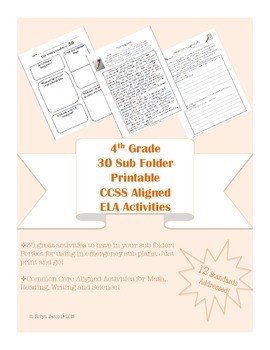4th Grade 30 CCSS Aligned worksheets & activities-for Sub Folder, Sub Tub
- PDF
- Easel Activity
Description
30 great activities to have in your sub folder! Perfect for using in emergency sub plans. Just print and go! Or, have students complete individual work virtually using the included Easel.
Activities for Math, Reading, Writing and Science! Each worksheet includes notation of the CCSS that it addresses.
Also includes: a fact sheet for you to fill out about your class, a form substitutes can use to leave you notes for the day, and a sheet for you to fill out with information about any behavioral situations subs should be aware of.
A master sheet lists each activity and whether it is for individual work, partner work, or small group work!
Answer Keys for all applicable worksheets
Worksheets address the following CCSS:
Math:
CCSS.MATH.CONTENT.4.OA.B.4
Find all factor pairs for a whole number in the range 1-100. Recognize that a whole number is a multiple of each of its factors. Determine whether a given whole number in the range 1-100 is a multiple of a given one-digit number. Determine whether a given whole number in the range 1-100 is prime or composite.
CCSS.MATH.CONTENT.4.NF.A.1
Explain why a fraction a/b is equivalent to a fraction (n × a)/(n × b) by using visual fraction models, with attention to how the number and size of the parts differ even though the two fractions themselves are the same size. Use this principle to recognize and generate equivalent fractions
CCSS.MATH.CONTENT.4.G.A.2
Classify two-dimensional figures based on the presence or absence of parallel or perpendicular lines, or the presence or absence of angles of a specified size. Recognize right triangles as a category, and identify right triangles.
CCSS.MATH.CONTENT.4.NBT.B.6
Find whole-number quotients and remainders with up to four-digit dividends and one-digit divisors, using strategies based on place value, the properties of operations, and/or the relationship between multiplication and division.
ELA:
CCSS.ELA-LITERACY.L.4.2
Demonstrate command of the conventions of standard English capitalization, punctuation, and spelling when writing.
CCSS.ELA-LITERACY.L.4.4.C
Consult reference materials (e.g., dictionaries, glossaries, thesauruses), both print and digital, to find the pronunciation and determine or clarify the precise meaning of key words and phrases.
CCSS.ELA-LITERACY.W.4.3
Write narratives to develop real or imagined experiences or events using effective technique, descriptive details, and clear event sequences.
CCSS.ELA-LITERACY.L.4.3
Use knowledge of language and its conventions when writing, speaking, reading, or listening.
CCSS.ELA-LITERACY.RI.4.1
Refer to details and examples in a text when explaining what the text says explicitly and when drawing inferences from the text.
CCSS.ELA-LITERACY.RL.4.3
Describe in depth a character, setting, or event in a story or drama, drawing on specific details in the text (e.g., a character's thoughts, words, or actions).
CCSS.ELA-LITERACY.RL.4.2
Determine a theme of a story, drama, or poem from details in the text; summarize the text.
CCSS.ELA-LITERACY.RL.4.1
Refer to details and examples in a text when explaining what the text says explicitly and when drawing inferences from the text.
You might also like the following 4th Grade ELA CCSS Aligned products:
4th Grade CCSS ELA Aligned Reading Comprehension packet #2
4th Grade Integrated Art Poetry Unit Orca Whales and Native Americans
4th Grade Integrated Art and Poetry Unit Orca Whales and Native Americans
4th Grade CCSS ELA Reading Comprehension Story Packet and Answers






